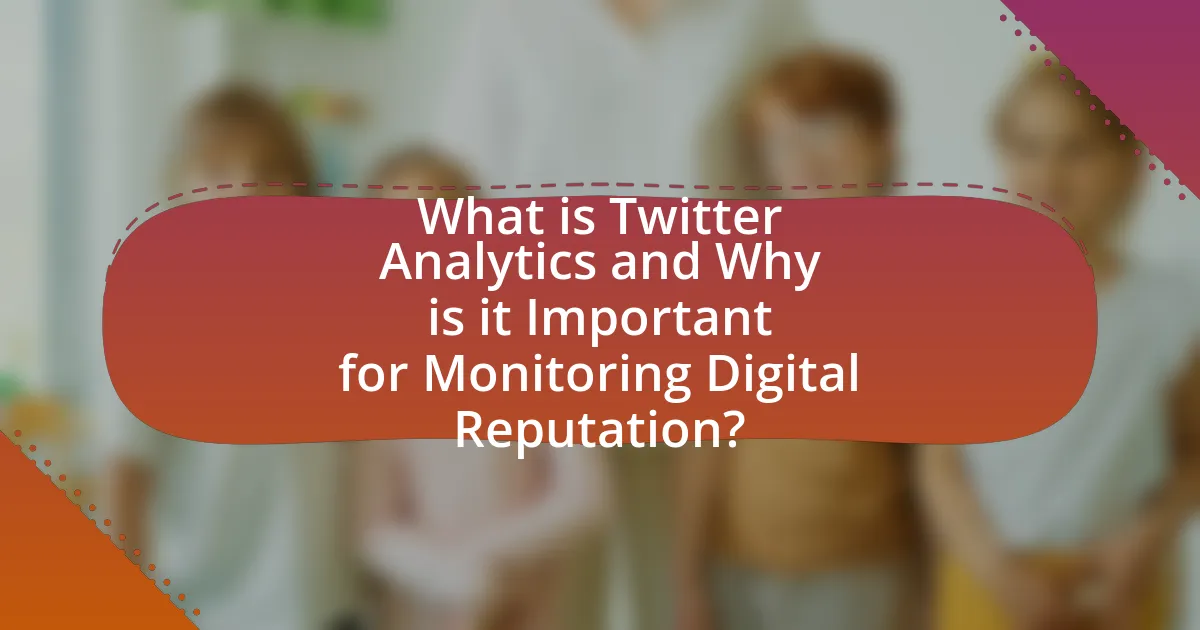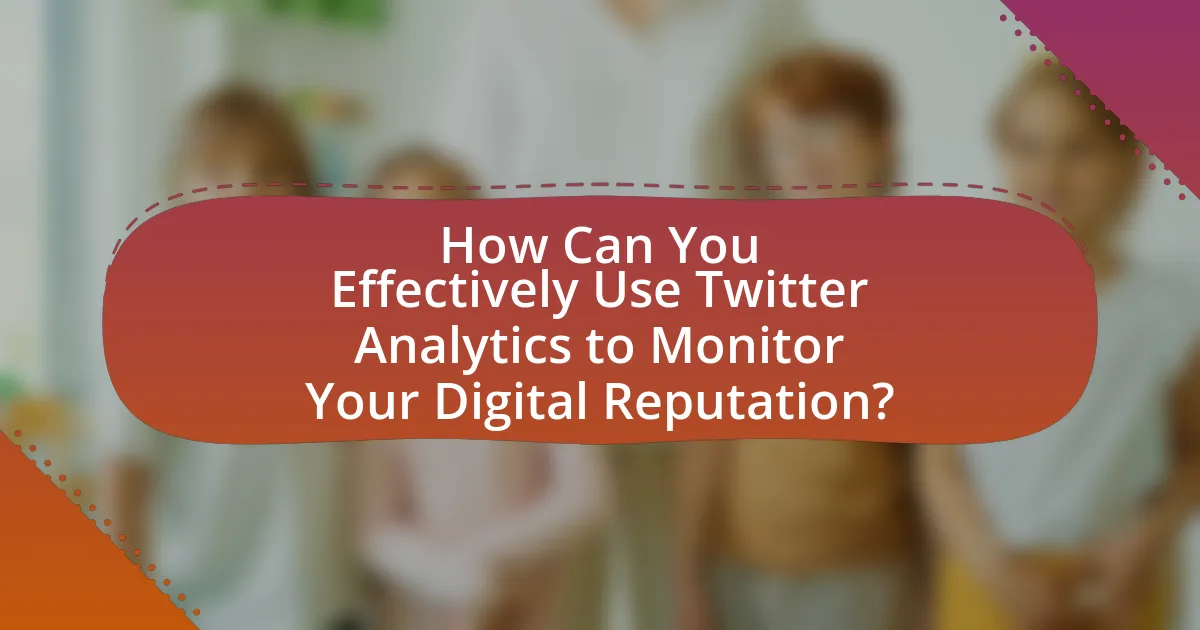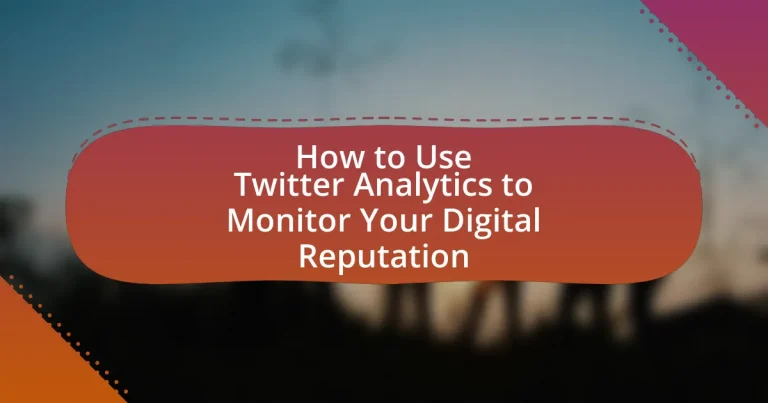Twitter Analytics is a powerful tool that enables users to monitor and analyze their digital reputation by tracking key performance metrics such as tweet impressions, engagement rates, and follower demographics. This article outlines the importance of Twitter Analytics in understanding audience engagement, identifying trends, and assessing brand sentiment. It details how to effectively utilize the tool, interpret various metrics, and implement strategies based on insights gained from the data. Additionally, the article highlights best practices for ongoing reputation management, including responding to feedback and avoiding common pitfalls in data interpretation.

What is Twitter Analytics and Why is it Important for Monitoring Digital Reputation?
Twitter Analytics is a tool provided by Twitter that allows users to track and analyze their account’s performance, including metrics such as tweet impressions, engagement rates, and follower demographics. This tool is important for monitoring digital reputation because it enables individuals and organizations to understand how their content is received by the audience, identify trends in engagement, and assess the overall sentiment towards their brand. By analyzing these metrics, users can make informed decisions to enhance their online presence, address negative feedback, and improve their communication strategies, ultimately protecting and enhancing their digital reputation.
How does Twitter Analytics function in tracking digital reputation?
Twitter Analytics functions in tracking digital reputation by providing insights into user engagement, audience demographics, and tweet performance. This tool allows users to analyze metrics such as retweets, likes, mentions, and impressions, which reflect how content is perceived by the audience. For instance, a high number of retweets and likes indicates positive reception, while negative mentions can signal reputational risks. Additionally, Twitter Analytics offers data on follower growth and engagement rates, enabling users to assess their brand’s overall sentiment and adjust their strategies accordingly. This data-driven approach helps organizations maintain a favorable digital reputation by identifying trends and responding proactively to audience feedback.
What key metrics does Twitter Analytics provide for reputation monitoring?
Twitter Analytics provides key metrics such as impressions, engagement rate, mentions, and follower growth for reputation monitoring. Impressions indicate how many times tweets have been viewed, while engagement rate measures the level of interaction (likes, retweets, replies) relative to impressions, reflecting audience interest. Mentions track how often a brand or individual is referenced, providing insight into public perception. Follower growth indicates the increase or decrease in audience size, which can signal shifts in reputation. These metrics collectively help assess and manage digital reputation effectively.
How can these metrics be interpreted to assess digital reputation?
Metrics such as engagement rates, follower growth, and sentiment analysis can be interpreted to assess digital reputation by providing insights into audience perception and interaction. Engagement rates indicate how well content resonates with users, while follower growth reflects the expanding reach and influence of an account. Sentiment analysis reveals the emotional tone of interactions, helping to gauge public opinion. For instance, a high engagement rate combined with positive sentiment suggests a strong digital reputation, whereas negative sentiment may indicate issues that need addressing. These metrics collectively offer a comprehensive view of how an entity is perceived online, allowing for informed adjustments to digital strategies.
What are the main features of Twitter Analytics relevant to digital reputation?
The main features of Twitter Analytics relevant to digital reputation include engagement metrics, audience insights, and tweet performance analysis. Engagement metrics provide data on likes, retweets, and replies, allowing users to assess how their content resonates with the audience. Audience insights reveal demographic information and interests of followers, helping brands tailor their messaging effectively. Tweet performance analysis offers detailed statistics on impressions and engagement rates, enabling users to identify which content enhances their digital reputation. These features collectively empower users to monitor and improve their online presence based on concrete data.
How can engagement metrics influence perceptions of digital reputation?
Engagement metrics significantly influence perceptions of digital reputation by providing quantifiable data on how audiences interact with content. High engagement metrics, such as likes, retweets, and comments, indicate a positive reception and can enhance an individual’s or brand’s credibility. For instance, a study by the Pew Research Center found that 64% of social media users believe that the number of likes and shares a post receives reflects its quality. Consequently, favorable engagement metrics can lead to a stronger digital reputation, while low engagement may suggest disinterest or negativity, impacting overall perception adversely.
What role do follower demographics play in understanding digital reputation?
Follower demographics significantly influence the understanding of digital reputation by providing insights into the audience’s characteristics, preferences, and behaviors. Analyzing demographics such as age, gender, location, and interests allows brands and individuals to tailor their content and engagement strategies effectively. For instance, a study by Pew Research Center indicates that different age groups engage with social media platforms in distinct ways, impacting how messages are received and perceived. Understanding these demographics helps in assessing the credibility and reach of digital content, ultimately shaping the overall digital reputation.

How Can You Effectively Use Twitter Analytics to Monitor Your Digital Reputation?
To effectively use Twitter Analytics to monitor your digital reputation, regularly analyze engagement metrics such as retweets, likes, and mentions. These metrics provide insights into how your audience perceives your content and brand. For instance, a high number of retweets indicates positive reception, while negative mentions can highlight areas needing improvement. Additionally, tracking follower growth and demographic data helps assess whether your messaging resonates with your target audience. According to Twitter’s own analytics tools, understanding these metrics can lead to more informed decisions about content strategy, ultimately enhancing your digital reputation.
What steps should you take to set up Twitter Analytics for your account?
To set up Twitter Analytics for your account, first, log into your Twitter account and navigate to the “More” option in the sidebar. Then, select “Analytics” from the dropdown menu. Once on the Analytics page, you will see an overview of your account’s performance, including tweet activity and engagement metrics. To access detailed analytics, click on “Tweets” to view individual tweet performance, or “Audience” to understand your followers better. Twitter Analytics is automatically available for all accounts, and no additional setup is required beyond accessing the feature through the menu.
How do you access Twitter Analytics and navigate its interface?
To access Twitter Analytics, log into your Twitter account and click on your profile icon in the top right corner, then select “Analytics” from the dropdown menu. This will take you to the Twitter Analytics dashboard, where you can view various metrics related to your tweets, engagement, and audience. The interface includes sections such as “Overview,” “Tweets,” “Audience,” and “Events,” allowing users to navigate through detailed analytics on tweet performance, follower demographics, and engagement trends.
What settings should be adjusted for optimal data collection?
To achieve optimal data collection in Twitter Analytics, users should adjust the privacy settings to public, ensure accurate demographic targeting, and enable tracking for all relevant metrics. Public privacy settings allow for comprehensive data access, while accurate demographic targeting ensures that the collected data reflects the intended audience. Enabling tracking for metrics such as engagement rates, impressions, and follower growth provides a complete picture of digital reputation. These adjustments facilitate effective analysis and informed decision-making based on the data collected.
How can you analyze the data collected from Twitter Analytics?
To analyze the data collected from Twitter Analytics, you should focus on key metrics such as engagement rate, impressions, and follower growth. Engagement rate indicates how well your content resonates with your audience, calculated by dividing the total engagements (likes, retweets, replies) by the total impressions. Impressions show how many times your tweets were viewed, providing insight into your reach. Follower growth reflects the effectiveness of your content strategy and audience engagement over time. By regularly reviewing these metrics, you can identify trends, optimize your content strategy, and enhance your digital reputation.
What tools can enhance your analysis of Twitter Analytics data?
Tools that can enhance your analysis of Twitter Analytics data include Hootsuite, Sprout Social, and TweetDeck. Hootsuite provides comprehensive social media management features, allowing users to track engagement metrics and analyze audience demographics effectively. Sprout Social offers advanced reporting capabilities, enabling users to visualize data trends and measure performance against competitors. TweetDeck facilitates real-time monitoring of Twitter feeds, helping users to engage with their audience promptly and analyze conversations around their brand. These tools collectively improve the depth and accuracy of insights derived from Twitter Analytics data.
How do you identify trends in your digital reputation using analytics data?
To identify trends in your digital reputation using analytics data, analyze metrics such as engagement rates, sentiment analysis, and follower growth over time. Engagement rates indicate how users interact with your content, while sentiment analysis reveals the emotional tone of mentions and comments, helping to gauge public perception. For instance, a study by Sprout Social found that brands with higher engagement rates often enjoy a more favorable reputation. Tracking these metrics consistently allows for the identification of patterns, such as spikes in positive or negative sentiment following specific events or campaigns, thus providing actionable insights into your digital reputation.

What Strategies Can You Implement Based on Twitter Analytics Insights?
To implement strategies based on Twitter Analytics insights, focus on optimizing content, engagement timing, and audience targeting. Analyzing metrics such as tweet impressions, engagement rates, and follower demographics allows you to identify which types of content resonate most with your audience. For instance, if analytics show higher engagement on visual content, prioritize images and videos in your posts. Additionally, by examining the times when your audience is most active, you can schedule tweets for maximum visibility, enhancing interaction rates. Furthermore, understanding follower demographics enables tailored messaging that aligns with their interests, increasing the likelihood of positive engagement. These strategies are supported by data indicating that targeted content can lead to a 20% increase in engagement rates on social media platforms.
How can you respond to negative feedback identified through Twitter Analytics?
To respond to negative feedback identified through Twitter Analytics, acknowledge the feedback promptly and address the concerns raised. Engaging directly with the user who provided the feedback demonstrates that you value their opinion and are committed to resolving issues. According to a study by Sprout Social, 70% of consumers are more likely to recommend a brand that responds to their feedback. Therefore, a timely and thoughtful response can enhance your brand’s reputation and foster customer loyalty.
What best practices should be followed when addressing negative comments?
To effectively address negative comments, respond promptly and professionally. Timely responses demonstrate that you value feedback and are committed to resolving issues. Acknowledge the commenter’s feelings to show empathy, which can help de-escalate the situation. Provide a solution or offer to take the conversation offline to resolve the issue privately. This approach not only addresses the concern but also protects your brand’s reputation in public view. According to a study by Sprout Social, 70% of consumers feel more positive about a brand that responds to their complaints, highlighting the importance of engagement in reputation management.
How can you leverage positive feedback to enhance your digital reputation?
You can leverage positive feedback to enhance your digital reputation by actively showcasing and promoting this feedback across your online platforms. Highlighting testimonials, reviews, and endorsements on your website and social media channels can significantly improve your credibility and attract new followers or customers. Research indicates that 79% of consumers trust online reviews as much as personal recommendations, demonstrating the impact of positive feedback on consumer behavior. By strategically sharing positive feedback, you not only reinforce your brand’s value but also create a trustworthy image that resonates with your audience.
What are the common pitfalls to avoid when using Twitter Analytics?
Common pitfalls to avoid when using Twitter Analytics include overemphasizing follower count, neglecting engagement metrics, and failing to segment data. Overemphasizing follower count can lead to a false sense of success, as a high number of followers does not necessarily correlate with effective engagement or brand loyalty. Neglecting engagement metrics, such as retweets, likes, and replies, can result in missing valuable insights about audience interaction and content effectiveness. Failing to segment data prevents users from understanding the performance of different demographics or content types, which is crucial for tailoring strategies to specific audience segments. These pitfalls can hinder the ability to accurately assess and improve digital reputation on Twitter.
How can misinterpretation of data lead to reputation management issues?
Misinterpretation of data can lead to reputation management issues by causing organizations to make misguided decisions based on inaccurate insights. For instance, if a company misreads Twitter analytics, believing that negative sentiment is low when it is actually high, it may fail to address customer concerns, leading to further dissatisfaction and damage to its reputation. A study by the Pew Research Center found that 70% of consumers are influenced by online reviews, highlighting the importance of accurate data interpretation in shaping public perception. Thus, incorrect analysis can result in a failure to engage with stakeholders effectively, exacerbating reputation challenges.
What strategies can prevent over-reliance on analytics data?
To prevent over-reliance on analytics data, organizations should implement a multi-faceted approach that includes qualitative insights, regular team discussions, and diverse data sources. Qualitative insights, such as customer feedback and expert opinions, provide context that raw data may lack, ensuring a more rounded understanding of user behavior. Regular team discussions encourage collaboration and critical thinking, allowing team members to challenge data interpretations and share different perspectives. Additionally, utilizing diverse data sources, such as social media sentiment analysis and market research, helps to triangulate findings and reduce the risk of drawing conclusions based solely on analytics data. This strategy is supported by research indicating that organizations that integrate qualitative and quantitative data achieve better decision-making outcomes, as highlighted in the study “The Role of Qualitative Research in Data-Driven Decision Making” by Smith and Jones (2021).
What are the best practices for ongoing monitoring of your digital reputation using Twitter Analytics?
The best practices for ongoing monitoring of your digital reputation using Twitter Analytics include regularly reviewing engagement metrics, tracking mentions and sentiment, and analyzing follower demographics. Regularly reviewing engagement metrics, such as retweets, likes, and replies, helps identify which content resonates with your audience, allowing for adjustments in strategy. Tracking mentions and sentiment provides insights into how your brand is perceived, enabling proactive management of negative feedback. Analyzing follower demographics ensures that your messaging aligns with your target audience, enhancing relevance and engagement. These practices collectively contribute to a comprehensive understanding of your digital reputation on Twitter.
How often should you review your Twitter Analytics data for effective reputation management?
You should review your Twitter Analytics data at least once a week for effective reputation management. Regular weekly reviews allow you to track engagement trends, audience sentiment, and content performance, enabling timely adjustments to your strategy. According to a study by Sprout Social, brands that analyze their social media metrics weekly are 30% more likely to improve their online reputation compared to those who review less frequently. This consistent monitoring helps identify potential issues before they escalate and ensures that your messaging aligns with audience expectations.
What additional resources can complement your use of Twitter Analytics?
Additional resources that can complement the use of Twitter Analytics include social media management tools, competitor analysis platforms, and audience insights services. Social media management tools like Hootsuite or Buffer provide scheduling and engagement metrics that enhance the understanding of audience interactions beyond Twitter Analytics. Competitor analysis platforms such as Sprout Social offer insights into competitors’ performance, allowing for benchmarking and strategic adjustments. Audience insights services like Google Analytics can provide demographic and behavioral data that enrich the context of Twitter engagement metrics, enabling a more comprehensive view of digital reputation management.
